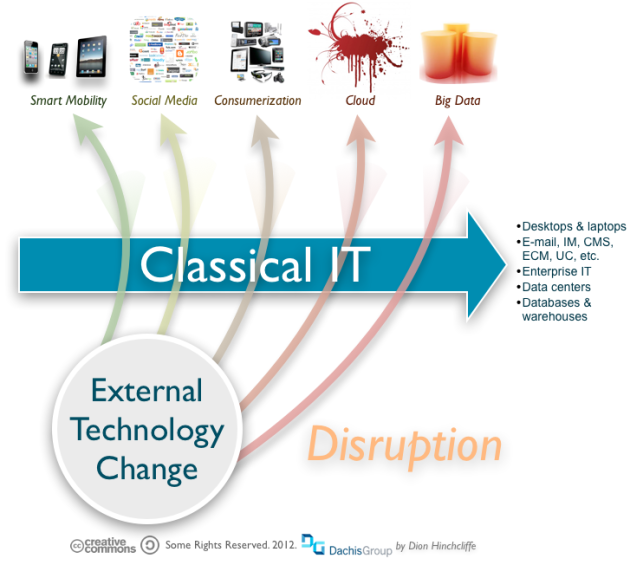Imagining the Future of the Enterprise
October 23, 2012 1 Comment
This afternoon at a workshop in Stuttgart, Germany at the KnowTech conference I explored our latest conception of the many transformative technology changes happening within our organizations today. The majority, if not most of these trends, are now being driven by the so-called “big shifts” — and our response to them as people, organizations, and society — that are largely being imposed from outside the walls of the enterprise. Consumerization is clearly here to stay. This is not to say that businesses aren’t innovating. Certainly they still are. But they are greatly outnumbered and frequently outclassed by the tsunami of new ideas sweeping across us from the consumer world.
The pace of advance today can seem overwhelming. It is new mobile devices, social media, cloud services, avalanches of sensor or crowd-created data, all brought to our doorstep via new digital channels and platforms such as mobile apps, app stores, open APIs, new social networks, gamification tools, to name just a few of the bigger and more disruptive technologies.
To proactively deal with all this, I currently advise most companies to develop a “strategy book” that they can readily use to identify important new advances, understand their abilities and ramifications, and then determine the impact to their business, both in terms of opportunity and challenges. Note: The aforementioned workshops typically provide the basis for such a strategy book and the processes required.
Unfortunately for most companies, there are often more challenges than opportunities, since many of these new technologies go against the grain of how traditional companies are structured and operate. Openness, decentralized processes, mass participation, network effects, and radically new distribution models for communication and work are not merely typical of today’s consumer technologies, it’s how they fundamentally work and compete against each other.

Put simply, to survive these generational shifts, organizations must figure out how to absorb new technology changes effectively and at scale. This will require potent strategies that will begin with requiring genuine rethinking of service delivery within our organizations and ultimately arrive at a profound transformation of the company. This will ultimately include its business models, motivations, and sometimes even its reasons for being. One can look at Amazon as an exemplar of this, starting out in e-commerce, and ending up a true and surprisingly pure digital platforms company, successfully wielding mobile, platforms, cloud, and big data to achieve market domination. Amazon is the most well known, but there are others and the route is repeatable, just as it is sometimes difficult.
The end point of all this is where everything is a service, as Dave Gray famously predicted. But also it’s more than that. The future of the enterprise, what I’m calling the next-generation enterprise, requires a mindset that doesn’t think in terms of fixed markets or point products or services. Instead, we must create, cultivate, and control fast-moving and highly competitive ecosystems of people, information, and value across a virtually unlimited number of channels. Those who can move first, co-create, and own the best class of information and then deliver it in forms the market wants, when it wants it, will be the winners in the short-term and long-term. Companies organized to do any less than this will falter and fade.
Over the last couple of years, I’ve been spending a lot of time thinking about and exploring how organizations can get there. There’s still a lot we need to learn, but we’re beginning to see the broad outlines. Unfortunately, there still more questions than answers, even today. Can most organizations make the transition? Does the transition to a next-generation enterprise have multiple routes, if so, what are they? How much investment is required and what is the likelihood of failure? Can we quantify and manage the risk of transforming? All of these questions and more remain difficult to answer.
Related: How Digital Business Will Evolve in 2012: 6 Big Ideas
However, we do know with a fair degree of certainty that most large organizations will need to begin changing faster — starting now — if they intend to survive. Most will need to become next-generation enterprises in a meaningful way within the next half-decade. And they need to have started several years ago.
As we enter the age of digital engagement, the untapped possibilities still largely exist. Most organizations should be utterly thrilled by the uncharted territories in front of them. Unfortunately, I see that most do not even see these as more than a threat, if they see them at all. That then is the first challenge: Changing how we regard our connection and relation to the world, for the biggest changes happening today are not only digital, but to ourselves and what makes our companies work.






























































